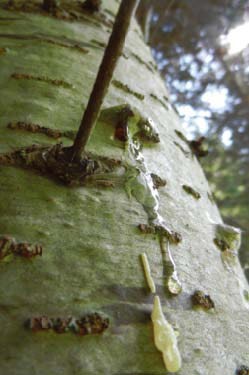Those bulging cysts on the otherwise very smooth, gray-brown bark are a distinguishing characteristic of balsam fir trees. They’re all over most fir stems. Aside from the really young and the oldest rough-barked trees, bark blisters are found on pretty much all balsam firs. They are as abundant and normal as needles and thought to be helpful in the tree’s system of defenses – especially against insects and pathogens. And people have made use of them for a very long time.
Inside each fir blister is a fragrant (impossible not to think Christmas), viscous, sticky, clear resin, also called pitch. It is not sap, which conifers also produce. Sap is mostly water with sugars, vitamins, hormones, and enzymes. It serves a nutritive function in the tree. Resin is very different. It is more like turpentine than sap. At this point we could discuss diterpenoids and oleoresins and the like, but let’s leave our comparison to sap at this: nobody makes delectable syrup from conifer resin, and archeology fans everywhere know resin in its hardened, fossilized form as amber.
All of our native and common conifers produce such resins, though how and where in the tree they are produced varies by groups of species. Resin in pines, spruces, and larches, for example, exists in resin canals – elongated, tubular spaces – within wood tissues. Fir resin, like that in hemlock and cedars, is found in the bark and only rarely – in response to traumatic injury – within the wood. In fact, the absence of resin ducts in the wood of fir is used in identifying and sorting fir boards from spruce.
But despite their great abundance, fir blisters still stir some scientific debate about their function. Whereas some researchers have classified conifer resin as a hydrocarbon compound of cellular waste products, others deem it a useful secretion, pointing to mounting evidence of its role in a range of protective functions. Evidently, these wastes defend the tree against a wide range of birds, mammals, insects, and pathogens. For example, insects attempting to pierce the bark of a balsam fir to feed on the sweet sap in the wood inside are thwarted by that sticky goo. Not only does it physically trap insects and impede their inward progress, it has some toxicity as well. It has also been speculated that the highly antiseptic qualities of resin help prevent wood decay.
Whatever debate remains about the mechanisms of resin’s benefits to trees, there is a long list of the ways that people made good use of balsam resin. Owing to its optical properties – it has a refractive index similar to ordinary glass – balsam was used as a medium for mounting microscope specimens and as a cement for optical systems like lenses and gun sights. For centuries it was used as a fixative and glossing agent on oil paintings and to waterproof pottery.
Many a northern woodsman has started a fire and sealed a wound with it – and no small amount of gear has been similarly patched. It has been used in dental procedures and cough syrups, as a vapor to ease headaches, and as an ingestible, to ease stomach aches. In a pinch, it’ll even do as crude chapstick.
Of course, now we have synthetics for most of these things, but they can’t take the fun of ingenuity away, and balsam resin delivers good entertainment. Sure, there’s the traditional thumbpress resulting in a sticky squirt aimed at your little brother. But there’s more. Poke a fir blister with a small dead twig and get a little gob of fir resin on the end. Now, drop that twig in a pool of water and be amazed at that quiet little “resin rocket motorboat.” The twig is propelled by the water-avoiding chemistry of the balsam resin. Who knew science could be so much fun?



Discussion *